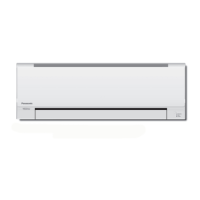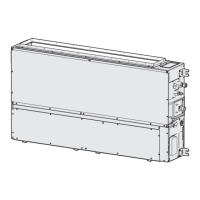2-60
Design of VRF SYSTEM
4. Optional Parts
2. Cutting and Flaring of Liquid Tube
After determining the position for installation, cut the liquid tube and flare the connecting portion.
(Pay attention to the notes below when flaring the tubes.)
Fig. 2-164
Copper tube projection for flaring: B (mm)
Rigid (clutch type)
R410A
R407C, R22
If special R410A
tool is used
B=0~0.5 1.0~1.5 0~0.5
If conventional
tool is used
If conventional
tool is used
3. Connection of External Electronic Expansion Valve with Tubing
In connection with tubing, take care to fit the
external electronic expansion valve in the right
direction. Be sure to install with the mark
on the label pointing upwards. Also when
connecting the flare, use the arrow marks on
the label to check the directions of the indoor
unit side and outdoor unit side.
(The wiring outlet side faces the indoor unit.)
(Refer to Fig. 2-165.)
UP
Fig. 2-165
Do not exceed
10 degrees
Do not exceed
10 degrees
Do not exceed
10 degrees
Do not exceed
10 degrees
Attached label on the unit
Unit: mm
B
EXTERNAL ELECTRONIC EXPANSION VALVE KIT
SOURCE
INDOOR
SIDE
OUTDOOR
SIDE
DC 12V
UP
SERIAL NO.
MUST BE INSTALLED AS ARROWS.
NOTE
After cutting the tube, deburr and finish the end face smoothly and correctly.
Do not damage tubes while flaring.
Take care not to allow dirt and deburred chips into the tube.
Use the flare nut which came with External Electronic Expansion Valve Kit.
The flaring dimensions for R410A are different from the conventional dimensions for R407C and R22. For R410A,
the specially created flaring tool is recommended.
However a conventional tool can be used by adjusting the amount of copper tube projection as shown in the table below.
Fig. 2-166
Tightening flare nuts
CAUTION
Be sure to use 2 spanners together when removing or
tightening the flare nuts. After connection with the tubing,
tighten the flare nuts by the correct torque. Failure to tighten
the nuts correctly can cause loosening and damage on the
flared portion, resulting in accidents by oxygen deficiency
due to refrigerant leaks.
Tubing size
Tightening torque
ø6.35 (1/4")
ø9.52 (3/8")
14~ 18 N · m
{140~180 kgf · cm}
34~ 42 N · m
{340~ 420 kgf · cm}
4. Flare Insulation of Tubing
After completing a leakage test, apply heat insulation. (Fig. 2-166)
Clamps (small)
Clamps (small)
Flare insulator
Insulating tape
* Use the flare insulator provided
with the product.
Flare insulator
Insulating tape
Be careful not to allow a gap to occur between
the thermal insulation of the tubing and the thermal
insulation of the main unit.
Indoor side Outdoor side
TDxxxxxx-002WAYVRF.indb60TDxxxxxx-002WAYVRF.indb60 2014/01/3017:52:322014/01/3017:52:32

